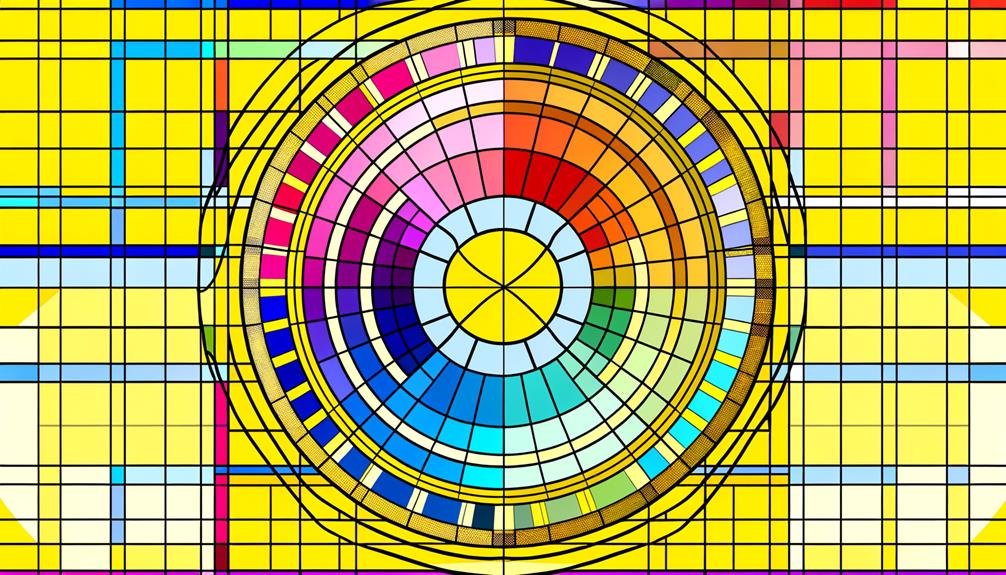Mastering Visual Design: Art Theory Application Tips
Understanding the intricate interplay between art theory and visual design is a fundamental aspect of creating impactful and aesthetically pleasing compositions. By dissecting renowned works like Raphael's 'The School of Athens,' designers can glean invaluable insights into the application of design principles.
However, mastering visual design goes beyond mere observation; it requires a nuanced understanding of how to effectively implement these theories in one's own work. Through a thoughtful exploration of key tips and techniques, designers can unlock the potential to elevate their craft and produce visually compelling designs that resonate with viewers on a deeper level.
Key Takeaways
- Understanding balance, pattern, and emphasis is crucial for mastering visual design.
- Applying design principles enhances visual appeal and engagement for effective communication.
- Analyzing historical artworks can inspire modern designs through timeless design principles.
- Critiquing and refining visual designs using art theory principles elevates design proficiency.
Key Principles of Visual Design
Utilizing fundamental principles of art theory, visual design serves as the cornerstone for creating aesthetically appealing and engaging compositions.
Color psychology plays a crucial role in evoking specific emotions and reactions within viewers. By strategically selecting colors based on their psychological impact, designers can effectively convey intended messages and enhance visual communication.
Additionally, incorporating Gestalt principles ensures that visual elements are arranged in a way that encourages the brain to perceive them as a unified whole rather than individual parts. This principle guides designers in creating cohesive and harmonious designs that captivate and hold the viewer's attention.
Understanding and applying these principles not only elevate the aesthetic quality of a composition but also contribute to its overall impact and effectiveness.
Visual Design Impact on Learning
The impact of visual design on learning is profound, shaping the way learners engage with and comprehend educational content. Learning engagement is heightened when visual design is appealing, capturing attention and stimulating cognitive processing.
Quality visual design not only enhances the aesthetic appeal but also plays a crucial role in information retention. When educational material is presented in a visually appealing manner, learners are more likely to remember and understand the content effectively.
Mastering Design Theory Application
Visual design theory application is a pivotal aspect in creating impactful and engaging visual content that enhances learning outcomes. To master design theory application effectively, consider the following:
- Design Theory Mastery: Understanding and applying design principles like balance, rhythm, and emphasis are essential for creating visually appealing content.
- Practical Applications: Implement design theory in real-world projects to enhance visual design innovation and experiment with creative techniques.
- Visual Design Innovation: Push boundaries by exploring new design trends, tools, and technologies to elevate the visual impact of your creations.
- Creative Techniques: Experiment with different design approaches, color schemes, and layouts to create visually stunning and effective visual designs.
Analyzing Design in Art History
Exploring the evolution of design principles through key historical art movements provides invaluable insights into the foundations of visual communication.
Artistic interpretation and design elements have played a significant role in shaping visual composition throughout history. Understanding how these elements were utilized in different historical contexts can offer a deeper appreciation for the visual arts and their impact on society.
From the Renaissance to the Modernist movement, artists have strategically employed design principles to convey messages, evoke emotions, and challenge viewers' perceptions. By analyzing design in art history, one can gain a better understanding of the techniques and strategies used by master artists to create compelling visual narratives that continue to resonate with audiences today.
Enhancing Visual Aesthetics
Analyzing the evolution of design principles through key historical art movements offers invaluable insights into enhancing visual aesthetics.
- Exploring color theory: Understanding the psychology of colors and how they interact can greatly impact visual appeal.
- Implementing typography techniques: Choosing the right fonts, sizes, and spacing can elevate the overall design.
- Experimenting with visual hierarchy: Manipulating the order and emphasis of elements can guide viewer attention effectively.
- Balancing negative space: Knowing when to leave areas empty is crucial for creating a harmonious composition.
Strategies for Effective Design Critique
Effective design critique is essential for refining visual creations and enhancing their impact on viewers. Providing constructive design feedback is crucial for improving visual balance and aesthetics.
When critiquing a design, it is important to focus on strategies that help enhance the overall composition. This can include analyzing the distribution of visual elements, evaluating the use of patterns and rhythms, and identifying areas where emphasis and contrast can be strengthened.
Improving Balance in Visuals
Achieving visual harmony through strategic placement of elements is key to enhancing balance in visual design. Visual balance is achieved by distributing visual weight evenly across a composition, ensuring that no single element overpowers the others.
To improve balance in visuals, consider the following:
- Creating Harmony: Ensure that elements complement each other to create a cohesive and pleasing composition.
- Considering Visual Weight: Pay attention to the perceived weight of elements to distribute them effectively.
- Utilizing Negative Space: Embrace empty spaces to provide visual breathing room and balance out the design.
- Experimenting with Symmetry and Asymmetry: Balance can be achieved through both symmetrical and asymmetrical arrangements, depending on the desired effect.
Elevating Design Principles Application
To further elevate the application of design principles, one can explore innovative ways to enhance visual harmony and composition. Design theory plays a crucial role in understanding how elements interact to create aesthetically pleasing visuals.
By delving into aesthetics analysis, designers can refine their understanding of color, shape, and space to create compelling compositions. Applying design principles like balance, pattern, and emphasis helps establish a strong foundation for creating visually impactful designs.
Precision in Design Feedback
Improving design outcomes necessitates providing specific and constructive feedback to enhance visual creations. When offering feedback to designers, employing precise evaluation techniques is crucial for aesthetic enhancement and overall design improvement.
Here are four key strategies to ensure your feedback is effective:
- Be Specific: Point out exact elements that need adjustment rather than vague generalizations.
- Focus on Objectivity: Provide feedback based on design principles and aesthetics rather than personal preferences.
- Offer Constructive Criticism: Suggest actionable steps for improvement to guide the designer in the right direction.
- Encourage Experimentation: Inspire designers to explore different approaches while keeping the project's goals in mind.
Advancing Visual Design Skills
Enhancing proficiency in visual design entails a deep understanding of fundamental principles and their application in diverse contexts. To advance visual design skills, exploring creativity and design innovation is essential.
Creativity allows designers to think outside the box, pushing boundaries to create unique and captivating visual solutions. Design innovation involves experimenting with new techniques, tools, and styles to enhance the visual impact of a design.
Conclusion
In the intricate tapestry of visual design, mastering the application of art theory principles is akin to conducting a symphony of creativity and precision.
By delving into the depths of design theory and drawing inspiration from iconic works of art, aspiring designers can unlock the secrets to creating visually compelling and impactful compositions.
Through a harmonious blend of balance, rhythm, and emphasis, designers can elevate their craft and captivate viewers with mesmerizing visual experiences.







